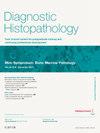Histopathological diagnosis of psoriasis and psoriasiform dermatitides
引用次数: 0
Abstract
The term psoriasiform dermatitis encompasses a group of skin diseases with lesions that exhibit clinical and histological similarities to psoriasis. Conditions such as pityriasis rubra pilaris, seborrheic dermatitis, and psoriasiform keratosis share alterations in certain pathogenetic mechanisms. These common mechanisms result in similar epidermal changes that define the psoriasiform pattern, characterized by regular acanthosis and abnormal cornification, often accompanied by corneal and subcorneal neutrophilic infiltrates. Despite these epidermal similarities, the dermal alterations can vary significantly among psoriasiform dermatoses. For instance, psoriasis typically presents with mild, non-specific superficial inflammation, whereas pityriasis lichenoides chronica is marked by abundant lymphocytic infiltrates, endothelial damage, and erythrocyte extravasation. Furthermore, the psoriasiform pattern frequently appears alongside other histopathological patterns. Spongiosis is a common finding, which may be incidental in psoriasis or a defining feature in seborrheic dermatitis. Lichenoid infiltrates are a defining feature in conditions such as pityriasis lichenoides chronica and pityriasis rubra pilaris and are also seen in psoriasiform cases of syphilis. Understanding the histological commonalities and distinctions, along with the clinical features of each condition, enables dermatopathologists to differentiate between various psoriasiform dermatoses and to identify specific disease entities based on their typical histopathological and clinical presentations.
银屑病和银屑病样皮炎的组织病理学诊断
术语牛皮癣样皮炎包括一组皮肤病,病变表现出临床和组织学上与牛皮癣相似。一些疾病如毛疹疹、脂溢性皮炎和牛皮癣状角化病在某些发病机制上有共同的改变。这些共同的机制导致了类似的表皮变化,定义了银屑病的模式,其特征是正常的棘层和异常的角化,通常伴有角膜和角膜下的中性粒细胞浸润。尽管表皮有这些相似之处,但银屑病样皮肤病的皮肤变化差异很大。例如,银屑病通常表现为轻度、非特异性浅表炎症,而慢性地衣样糠疹则表现为大量淋巴细胞浸润、内皮损伤和红细胞外渗。此外,牛皮癣样模式经常与其他组织病理模式一起出现。海绵状病是一种常见的发现,它可能是银屑病的偶然现象,也可能是脂溢性皮炎的典型特征。类地衣浸润是慢性类地衣癣和毛毛红斑性糠疹等疾病的典型特征,也见于银屑病样梅毒病例。了解组织学的共性和区别,以及每种疾病的临床特征,使皮肤病理学家能够区分各种牛皮癣样皮肤病,并根据其典型的组织病理学和临床表现识别特定的疾病实体。
本文章由计算机程序翻译,如有差异,请以英文原文为准。
求助全文
约1分钟内获得全文
求助全文
来源期刊

Diagnostic Histopathology
Medicine-Pathology and Forensic Medicine
CiteScore
1.30
自引率
0.00%
发文量
64
期刊介绍:
This monthly review journal aims to provide the practising diagnostic pathologist and trainee pathologist with up-to-date reviews on histopathology and cytology and related technical advances. Each issue contains invited articles on a variety of topics from experts in the field and includes a mini-symposium exploring one subject in greater depth. Articles consist of system-based, disease-based reviews and advances in technology. They update the readers on day-to-day diagnostic work and keep them informed of important new developments. An additional feature is the short section devoted to hypotheses; these have been refereed. There is also a correspondence section.
 求助内容:
求助内容: 应助结果提醒方式:
应助结果提醒方式:


